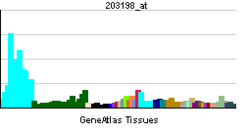Cyclin-dependent kinase 9
From Wikipedia, the free encyclopedia
| Cyclin-dependent kinase 9 | |||||||||||
|---|---|---|---|---|---|---|---|---|---|---|---|
 Rendering based on PDB 1PF6. |
|||||||||||
|
|||||||||||
| Identifiers | |||||||||||
| Symbols | CDK9; C-2k; CDC2L4; CTK1; PITALRE; TAK | ||||||||||
| External IDs | OMIM: 603251 MGI: 1328368 HomoloGene: 55566 ChEMBL: 3116 GeneCards: CDK9 Gene | ||||||||||
| EC number | 2.7.11.22, 2.7.11.23 | ||||||||||
|
|||||||||||
| RNA expression pattern | |||||||||||
 |
|||||||||||
| More reference expression data | |||||||||||
| Orthologs | |||||||||||
| Species | Human | Mouse | |||||||||
| Entrez | 1025 | 107951 | |||||||||
| Ensembl | ENSG00000136807 | ENSMUSG00000009555 | |||||||||
| UniProt | P50750 | Q99J95 | |||||||||
| RefSeq (mRNA) | NM_001261 | NM_130860 | |||||||||
| RefSeq (protein) | NP_001252 | NP_570930 | |||||||||
| Location (UCSC) | Chr 9: 130.55 – 130.55 Mb |
Chr 2: 32.71 – 32.71 Mb |
|||||||||
| PubMed search | [1] | [2] | |||||||||
|
|
Interactions
CDK9 has been shown to interact with Cyclin K,[3] Cyclin T2,[4] RELA,[5] Cyclin T1,[3][4][6][7][8][9][10][11][12] Retinoblastoma protein,[13] Androgen receptor,[14] SKP1A,[10] MYBL2,[11] CDC34[10] and SUPT5H.[12](TO BE CONTINUED!)
No comments:
Post a Comment